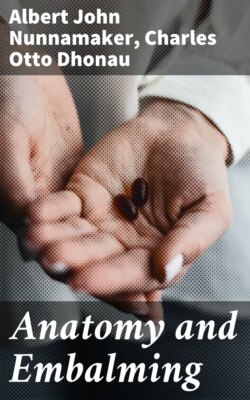Читать книгу Anatomy and Embalming - Charles Otto Dhonau - Страница 24
На сайте Литреса книга снята с продажи.
Later European Embalming.
Оглавление—After the previous discussion of the care of the dead affecting prehistoric as well as the earliest historic usages, we are brought forward to the seventeenth century. All embalming processes of the earlier days having been forgotten during the dark ages. The slow but sure development of the medical profession having manifested a dire necessity for the preservation of anatomical material, this necessity was first met by Dr. Frederick Ruysch, who occupied the chair of anatomy at Amsterdam, Holland, during the close of the seventeenth and early years of the eighteenth century (1665–1717).
Dr. Ruysch was probably the first to practice a successful system of arterial injection, in order that his anatomical specimens might resist the processes of decay. The reader should understand that embalming as a convenient process for preserving human dead bodies for funeral purposes had not been thought of at this time, and the principal interest in embalming was for its successful preservation of anatomical specimens. The method followed by Dr. Ruysch, was first an arterial injection, then allowing the diffusion of the fluid for some hours, after which, he proceeded to open the body as in making a postmortem examination, removing the viscera, cleaning them and replacing them surrounded with a preservative solution. Dr. Ruysch died, leaving his secrets buried with him, and they were lost to science.
Dr. William Hunter, an eminent Scottish physician, anatomist and physiologist of the eighteenth century (1718–1783) is given credit by many as being the original inventor of the injection system, for he published his plan of injection in minute detail, so that science might benefit thereby. The artery usually selected by Dr. Hunter was the femoral and his solution was composed of oil of turpentine five pints; Venice turpentine, one pint; oil of lavender, two fluid ounces; oil of rosemary, two fluid ounces; and vermillion. This was forced into the vessel until it reached over the whole body, giving the skin a general reddish appearance. As in Dr. Ruysch's method, the body was left untouched for a time, and was then opened, the viscera being treated and placed back again. After treating the exterior of the body in some cases, a coffin was prepared and the body was placed on a bed of dry plaster of paris in order that desiccation might set in. The body was then left for four years and if dryness had not set in by that time, was placed upon another bed of plaster of paris. Some of Hunter's specimens are to be seen today in the museum of the Royal College of Surgeons, London.
Dr. John Hunter, a younger brother of William, was also very active in experimentation along these lines, and his work was little less renowned along the same lines. The Hunterian method was used for years by English anatomists with little if any alteration.
M. Boudet, attempted to use the Egyptian form of procedure in embalming, using as preservative agents corrosive sublimate, tan, salt, asphalt, Peruvian bark, camphor, cinnamon, and other aromatics. He completely enveloped the body in bandages, varnish being coated over the body and cavities and outer bandages.
M. Franchini, injected the common carotid artery with a solution made up of eight decigrams of arsenious acid, combined with a small quantity of cinnabar, dissolved in nine kilograms of spirits of wine. By this method bodies could be kept odorless and natural in color for sixty days, after which desiccation set in.
Jean Nicholas Gannal, and his son Dr. Gannal of Paris, injected chloride of alumina with success, J. N. Gannal, had previously, a formula containing arsenic, which the French Government compelled him to discontinue by prohibiting the sale of the arsenic. In addition to the above treatment the body was placed in a lead coffin and four or five litres of various essences were poured over the body and the casket was soldered. In this way preservation was said to be indefinite.
M. Sucquet, injected a solution of chloride of zinc arterially, and in one body which was taken up after being buried 14 months achieved remarkable success, the incident being the result of a contest between M. Gannal, M. Dupre, and M. Sucquet. This led to the use of the zinc salts in fluid, not only in Europe but in this country as well.
M. Falcony, desiccated the body in a mixture which was composed of saw dust and powdered zinc sulphate. Bodies so preserved remained flexible for about forty days, after which they dried up, although still retaining their natural color.
Franciolli, used arsenic acid, four ounces; carbonate of potash, two ounces; powdered alum, eight ounces. He completely eviscerated the body and then injected it in all directions, afterwards replacing the organs and surrounding them with liquid preparation composed of corn starch, water, alcohol, and corrosive sublimate, which after hardening, would prevent the sinking of the parts.
Many processes are noted in the various histories of the art, all using the arterial injection, which by this time had become universally accepted as the only true way of reaching the body tissues completely. The reader has noted absolutely nothing as to embalming being the most convenient process for funeral purposes. This is left to the following matter which begins with the embalming done by Dr. Thomas Holmes during the civil war (1861–1865 AD)
